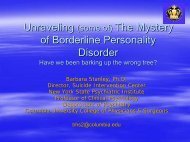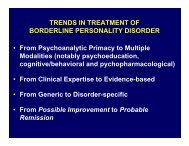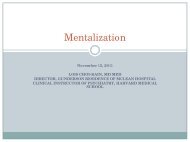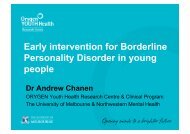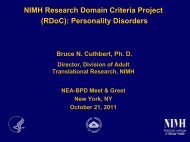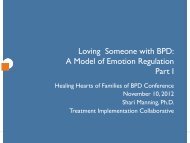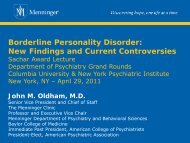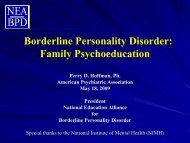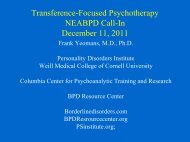A BPD Brief - Borderline Personality Disorder
A BPD Brief - Borderline Personality Disorder
A BPD Brief - Borderline Personality Disorder
Create successful ePaper yourself
Turn your PDF publications into a flip-book with our unique Google optimized e-Paper software.
___________________________________________________________________________ 6The Origins of <strong>BPD</strong><strong>Borderline</strong> <strong>Personality</strong> <strong>Disorder</strong>, like all other major psychiatric disorders, is caused by acomplex combination of genetic, social, and psychological factors. All modern theories nowagree that multiple causes must interact with one another in order for the disorder to becomemanifest.There are, however, known risk factors for the development of <strong>BPD</strong>. The risk factors includethose present at birth, called temperaments; experiences occurring in childhood; andsustained environmental influences.A. Inborn Biogenetic TemperamentsThe degree in which <strong>Borderline</strong> <strong>Personality</strong> <strong>Disorder</strong> is caused by inborn factors, called the“level of heritability” is estimated to be 52-68%. This is about the same as for bipolar disorder.What is believed to be inherited are the biogenetic dispositions, i.e., temperaments, (or, asnoted above, phenotypes), for Affective Dysregulation, Impulsivity, and InterpersonalHypersensitivity. For children with these inborn dispositions, environmental factors can thensignificantly delimit or exacerbate them into adult <strong>BPD</strong>. But, in addition, some more <strong>BPD</strong>specificdisposition is inherited that glues these phenotypes together.Many studies have shown that disorders of emotional regulation, interpersonalhypersensitivity, or impulsivity are disproportionately higher in relatives of <strong>BPD</strong> patients.The affect/emotion temperament predisposes individuals to being easily upset, angry,depressed, and anxious. The impulsivity temperament predisposes individuals to act withoutthinking of the consequences, or even to purposefully seek dangerous activities. Theinterpersonal hypersensitivity temperament probably starts with extreme sensitivity toseparations or rejections. Another theory has proposed that patients with <strong>BPD</strong> are born withexcessive aggression which is genetically based (as opposed to being environmental inorigin). A child born with a cheerful, warm, placid or passive temperament would be unlikely todevelop <strong>BPD</strong>.Normal neurological function is needed for such complex tasks as impulse control, regulation ofemotions, and perception of social cues. Studies of <strong>BPD</strong> patients have identified an increasedincidence of neurological dysfunctions, often subtle that are discernible on close examination. Thelargest portion of the brain is the cerebrum, where information is interpreted coming in from thesenses, and from which conscious thoughts and planned behavior emanate. Preliminary studieshave found that individuals with <strong>BPD</strong> have a diminished response to emotionally intense stimulationin the planning/organizing areas of the cerebrum and that the lower levels of brain activity maypromote impulsive behavior. The limbic system, located at the center of the brain, is sometimesthought of as “the emotional brain”, and consists of the amygdala, hippocampus, thalamus,hypothalamus and parts of the brain stem. There is evidence that in response to emotional arousal,the amygdale is particularly active in persons with <strong>BPD</strong>.B. Psychological FactorsLike most other mental illnesses, <strong>Borderline</strong> <strong>Personality</strong> <strong>Disorder</strong> does not appear to originate duringa specific, discrete phase of development. Recent studies have suggested that pre-borderlinechildren fail to learn accurate ways to identify feelings or to accurately attribute motives inthemselves and others (often called failures of “mentalization”). Such children fail to develop basicmental capacities that constitute a stable sense of self and make themselves or othersunderstandable or predictable. One important theory has emphasized the critical role of an____________________________________________________________________________A <strong>BPD</strong> <strong>Brief</strong>: Revised 2011
___________________________________________________________________________ 7invalidating environment. This occurs when a child is led to believe that his or her feelings, thoughtsand perceptions are not real or do not matter.About 70% of people with <strong>BPD</strong> report a history of physical and/or sexual abuse. Childhood traumasmay contribute to symptoms such as alienation, the desperate search for protective relationships,and the eruption of intense feeling that characterize <strong>BPD</strong>. Still, since relatively few people who arephysically or sexually abused develop the borderline disorder (or any other psychiatric disorder) it isessential to consider temperamental disposition. Since <strong>BPD</strong> can develop without such experiences,these traumas are not sufficient or enough by themselves to explain the illness. Still, sexual or otherabuse can be the “ultimate” invalidating environment. Indeed, when the abuser is a caretaker, thechild may need to engage in splitting (denying feelings of hatred and revulsion in order to preservethe idea of being loved). Approximately 30% of people with <strong>BPD</strong> have experienced early parentalloss or prolonged separation from their parents, experiences believed to contribute to the borderlinepatient’s fears of abandonment. People with <strong>BPD</strong> frequently report feeling neglected during theirchildhood. Sometimes the sources for this sense of neglect are not obvious and might be due to asense of not being sufficiently understood. Patients often report feeling alienated or disconnectedfrom their families. Often they attribute the difficulties in communication to their parents. However,the <strong>BPD</strong> individual’s impaired ability to describe and communicate feelings or needs, or resistance toself-disclosure may be a significant cause of the feelings of neglect and alienation.C. Social and Cultural FactorsEvidence shows that borderline personality is found in about 2-4% of the population. There may besocietal and cultural factors which contribute to variations in its prevalence. A society which is fastpaced;highly mobile, and where family situations may be unstable due to divorce, economic factorsor other pressures on the caregivers, may encourage development of this disorder.The Course of <strong>Borderline</strong> <strong>Personality</strong> <strong>Disorder</strong><strong>Borderline</strong> <strong>Personality</strong> <strong>Disorder</strong> usually manifests itself in early adulthood, but symptoms of it (e.g.,self-harm) can be found in early adolescence. As individuals with <strong>BPD</strong> age, their symptoms and/orthe severity of the illness usually diminish. Indeed, about 40-50% of borderline patients remit withintwo years and this rate rises to 85% by 10 years. Unlike most other major psychiatric disorders,those who do remit from <strong>BPD</strong> don’t usually relapse! Studies of the course of <strong>BPD</strong> have indicatedthat the first five years of treatment are usually the most crisis-ridden. A series of intense, unstablerelationships that end angrily with subsequent self-destructive or suicidal behaviors arecharacteristic. Although such crises may persist for years, a decrease in the frequency andseriousness of self-destructive behaviors and suicidal ideation and acts and a decline in both thenumber of hospitalizations and days in hospital are early indications of improvement. Whereas about60% of hospitalized <strong>BPD</strong> patients are readmitted in the first six months, this rate declines to about35% in the eighteen months to two-year period following an initial hospitalization. In general,psychiatric care utilization gradually diminishes and increasingly involves briefer, less intensiveinterventions.Improvements in social functioning proceed more slowly and less completely than do the symptomremissions. Only about 25% of the patients diagnosed with <strong>BPD</strong> eventually achieve relative stabilitythrough close relationships or successful work. Many more have lives that include only limitedvocational success and become more avoidant of close relationships. While stabilization is common,and life satisfaction is usually improved, the persisting impairment of social role functioning of thepatients is often disappointing.____________________________________________________________________________A <strong>BPD</strong> <strong>Brief</strong>: Revised 2011
___________________________________________________________________________ 8Suicidality and Self-Harm BehaviorThe most dangerous and fear-inducing features of <strong>Borderline</strong> <strong>Personality</strong> <strong>Disorder</strong> are the self-harmbehavior and potential for suicide. While 8-10% of the individuals with <strong>Borderline</strong> <strong>Personality</strong><strong>Disorder</strong> commit suicide, suicidal ideation (thinking and fantasizing about suicide) is pervasive in theborderline population. Deliberate self-harm behaviors (sometimes referred to as parasuicidal acts)are a common feature of <strong>BPD</strong>, occurring in approximately 75% of patients having the diagnosis andin an even higher percentage for those who have been hospitalized. These behaviors can result inphysical scarring, and even disabling physical handicaps.Self-harm behavior takes many forms. Patients with <strong>BPD</strong> often will self-injure without suicidal intent.Most often, the self-injury involves cutting, but can involve burning, hitting, head banging, and hairpulling. Some self-destructive acts are unintentional, or at least are not perceived by the patient asself-destructive, such as unprotected sex, driving under the influence, or binging and purging.Tattoos or pornography with retrospective shame are new variations of this.The motivations for self-injurious behaviors are complex, vary from individual to individual, and mayserve different purposes at different times. About 40% of self-harming acts done by borderlinepatients occur during dissociative experiences, times when numbness and emptiness prevail. Forthese patients self-injury may be the only way to experience feelings at all. Patients report thatcausing themselves physical pain generates relief which temporarily alleviates excruciating psychicpain. Sometimes people with <strong>BPD</strong> make suicide attempts when they feel alone and unloved, orwhen life feels so excruciatingly painful as to feel unbearable. There may be a vaguely conceivedplan to be rescued, which represents an attempt to relieve the intolerable feelings of being alone byestablishing some connection with others. There may even be a neurochemical basis for some selfharmingacts – the physical act may result in a release of certain chemicals (endorphins) whichinhibit, at least temporarily, the inner turmoil. Self-destructive behaviors can become addictive, andone of the initial and primary components of treatment is to break this cycle.In addition to substance abuse, major depression can contribute to the risk of suicide.Approximately 50% of people with <strong>BPD</strong> are experiencing an episode of major depression when theyseek treatment, and about 80% have had a major depressive episode in their lifetimes. Whendepression coexists with the inability to tolerate intense emotion, the urge to act impulsively isexacerbated. It is imperative that treaters evaluate the patient’s mood carefully, appreciate theseverity of the patient’s unhappiness, but also recognize that antidepressant medications usuallyhave only modest effects.Family members are, understandably, tormented by the threat and/or carrying out of such acts.Reactions, naturally, vary widely, from wanting to protect the patient, to anger at the perceivedattention-demanding aspects of the behavior. The risk of suicide incites fear, anger, andhelplessness. It is imperative, however, that family members do not assume the primary burden toensure the patient’s safety. Whenever there is a perceived threat of harm, or the patient has alreadyengaged in self-harm, a professional should be contacted.The borderline individual may plead to keep communications or behaviors secret, but safety must bethe priority. The patient, treaters, and family cannot work together effectively without candor, and thethreat or occurrence of self-destructive acts cannot be kept secret. This is for the benefit of allconcerned. Family members/friends do not have the capacity to live with the specter of thesebehaviors in their lives, and patients will not progress in their treatment until these behaviors areeliminated.Once safety concerns have been addressed, through the intervention of professionals, familymembers/friends can play an important role in diminishing the likelihood of recurring self-destructive____________________________________________________________________________A <strong>BPD</strong> <strong>Brief</strong>: Revised 2011
___________________________________________________________________________ 9threats by simply being present and listening to their loved one, without criticism, rejection ordisapproval.<strong>BPD</strong> individuals often misuse alcohol or drugs (both prescribed and illegal). This may diminish socialanxiety, distance them from painful ruminations, or minimize the intensity of their negative emotions.Often alcohol or drugs have disinhibiting affects that encourage self-injury and suicide attempts aswell as other self-endangering behaviors.Current Status of TreatmentIn the past few decades, treatment for <strong>Borderline</strong> <strong>Personality</strong> <strong>Disorder</strong> has changed radically, and, inturn, the prognosis for improvement and/or recovery has significantly improved.One of the preliminary questions confronting families/friends is how and when to place confidence inthose responsible for treating the patient. Generally speaking, the more clinical experience thetreater(s) have working with borderline patients, the better. In the event that several professionalsare involved in the care of a borderline individual, it will be important that they are compatible in theirapproaches and are communicating with one another. Support by family members of treatment isequally important.A. HospitalizationHospitalization in the care of borderline patients is usually restricted to the management of crises(including, but not limited to, situations where the individual’s safety is precarious). Hospitals providea safe place where the patient has an opportunity to gain distance and perspective on a particularcrisis and where professionals can assess the patient’s psychological and social problems andresources. It is not uncommon for medication changes to take place in the context of a hospital stay,where professionals can monitor the impact of new medications in a controlled environment.Hospitalizations are usually short in duration.B. PsychotherapyPsychotherapy is the cornerstone of most treatments of borderline patients. Although developmentof a secure attachment to the therapist is generally essential for the psychotherapy to have usefuleffects, this does not occur easily with the borderline patient, given his or her intense needs andfears about relationships.Moreover, many therapists are apprehensive about working with borderline patients. Thesymptomology of the borderline patient can be as difficult for professionals as it is for familymembers. The treater may assume the role of protective caretaker, and then experience feelings ofanger and fear when the patient engages in dangerous and maladaptive behaviors. Even very able,motivated therapists are sometimes abruptly terminated by borderline patients. Often, however,though experienced as a failure, these brief therapies turn out to have served a valuable role inhelping the patient through an otherwise insurmountable situation and in making the patient moreamenable to subsequent therapists.The standard recommendation for individual psychotherapy involves one to two visits a week with anexperienced clinician for a period of one to six years. Good therapists need to be active and maintainconsistent expectations of change and patient participation. Essential to successful therapy for aborderline patient is the development of feelings of trust and closeness with the therapist (which mayhave been missing from the patient’s life to that point) with the expectation that this would enhance____________________________________________________________________________A <strong>BPD</strong> <strong>Brief</strong>: Revised 2011
___________________________________________________________________________ 10the ability of the patient to have relationships of this nature with others. Validation, including beinglistened to, helps individuals develop recognition and acceptance of their self as unique and worthy.Multiple forms of psychotherapy have been shown by research to be effective. All of them decreaseself-harm, suicidality, and use of hospitals, emergency rooms, and medications. The best knownand most widely practiced of the empirically validated therapies is Dialectical Behavior Therapy(DBT). It combines individual and group therapy modalities and is directed at teaching the borderlinepatient skills to regulate intense emotional states and to diminish self-destructive behaviors. DBTincludes the concept of mindfulness, including self-awareness and balancing cognitive andemotional states, resulting in “wise mind.” DBT also emphasizes regulating emotions; distresstolerance skills and effective interpersonal skills. This therapy’s proactive, problem-solving approachreadily engages borderline patients who are motivated to change.Two of the effective therapies for <strong>BPD</strong> are psychodynamic (aka psychoanalytic). Transferencefocused psychotherapy (TFP) is a twice-weekly individual psychotherapy that emphasizes theinterpretation of the meaning for the patient’s behaviors within relationships, most notably therelationship with the therapist. TFP also emphasizes the importance of experiences of anger.Mentalization based therapy (MBT) combines individual and group therapy. It emphasizes learningto recognize one’s own mental states (feelings/attitudes) and those of others as ways of explainingbehaviors. This capability is called mentalizing, and is a capacity that all effective therapies try toenhance.General Psychiatric Management (GPM) is a once-weekly therapy that can include prescribingmedications and family interventions as needed. The therapy tries to create a “containingenvironment” within which patients can learn to trust and feel. This therapy requires clinicalexperience, but is the least theory-bound and easiest to learn of the empirically validated therapies.C. PharmacotherapySelective serotonin reuptake inhibitors and other antidepressants have frequently been prescribed topatients with <strong>BPD</strong>, but they are only modestly useful. Randomized controlled trials now suggest thatatypical antipsychotics or mood stabilizers may be better choices. These studies also show that notype of medication is consistently or dramatically effective. Benzodiazepines are the one class ofmedications shown to make patients worse, though even here, there are exceptions. Thusmedications should be initiated with the full understanding by the borderline patient that they have anadjunctive role to psychotherapy in treatment. In practice, prescribing medications may help tofacilitate a positive alliance by concretely demonstrating the physician’s wish to help the borderlinepatient feel better; but unrealistic expectations of the benefits of medication can undermine work onself-improvement.Common concerns when prescribing medication to these patients include risks of overdosing andnon-compliance, but experience suggests that medications can be used with much reduced risk aslong as a patient is regularly seeing and communicating with his or her provider. Another commonproblem in practice is polypharmacy, which may occur when patients want to continue or addmedications despite a lack of demonstrable benefit; eighty percent of borderline patients are takingthree or more medications. Consequences include side effects such as obesity (especially withantipsychotic agents) and associated problems such as hypertension and diabetes. When the benefitof a medication is unclear, patients should be urged to discontinue it before initiating a new one.____________________________________________________________________________A <strong>BPD</strong> <strong>Brief</strong>: Revised 2011
___________________________________________________________________________ 11D. Family InterventionsParents and spouses often bear a significant burden. They usually feel misjudged and unfairlycriticized when the person with <strong>BPD</strong> blames them for their suffering. Suffice it to say, that for boththe borderline patient, and those who love them, living with this disorder is challenging. Familymembers are usually grateful to be educated about the borderline diagnosis, the likely prognosis,reasonable expectations from treatment, and how they can contribute. Such interventions oftenimprove communication, decrease alienation, and relieve family burdens.Conjoint sessions with parents and the <strong>BPD</strong> offspring should be offered both the borderline patientand their parents need to be motivated to participate, to have established an ability to communicatewith words (rather than actions) and to willing listen to each other.E. Group TherapiesGroup therapies include those led by professionals, with selected membership, and self-help groups,comprised of people who gather together to discuss common problems. Both are effectivetreatments.DBT skills groups are often like classrooms with much focus and direction offered by the groupleader and with homework between sessions. MBT groups offer a form for recognizingmisattributions and how one affects others. <strong>Borderline</strong> patients may be resistant to interpersonal orpsychodynamic groups which require the expression of strong feelings or the need for personaldisclosures. However, such forums may be useful for these very reasons. Moreover, such groupsoffer an opportunity for borderline patients to learn from persons with similar life experiences, which,in conjunction with the other modalities discussed here, can significantly enhance the treatmentcourse.Many borderline patients will find it more acceptable to join self-help groups, such as AA, and othergroups that are directed to problems such as eating disorders or that have purely supportivefunctions, such as Survivors of Incest. Such self-help groups that provide a network of supportivepeers can be useful ad an adjunct to treatment, but should not be relied on as the sole source ofsupport.ConclusionDespite its prevalence in clinical settings and its enormous public health costs, borderline personalitydisorder has only recently begun to command the attention it requires. This is evident in theemergence of parental advocacy/education/support groups, in the identification of <strong>BPD</strong> as a priorityby the National Institute of Mental Health (NIMH) and by the National Alliance on Mental Illness(NAMI) in 2006. In 2009, the US Congress passed a resolution calling for more awareness of thisdisorder and more investment into its research and treatment. To date this has not occurred.Our understanding of the disorder itself is in the process of dramatic change. Where its etiology wasonce thought to be exclusively environmental, we now know it is heavily genetic. Where it wasthought to be a highly chronic, resistant-to-change disorder, we now know it has a remarkably goodprognosis. Finally, where once it was thought to require heroic commitments to undertake <strong>BPD</strong>treatment, we now have a variety of interventions specifically designed for <strong>BPD</strong>, which can havesignificant and enduring benefits.____________________________________________________________________________A <strong>BPD</strong> <strong>Brief</strong>: Revised 2011
___________________________________________________________________________ 12RESOURCESBehavioral Technology LLCDBT referral, training and resources4556 University Way NE, Suite 200Seattle, Washington 98105(206) 675-8588 www.behavioraltech.com E-mail: information@behavioraltech.org<strong>Borderline</strong> <strong>Personality</strong> <strong>Disorder</strong> Resource Center<strong>BPD</strong> referral to resources and treatmentNew York Presbyterian Hospital-Westchester Division21 Bloomingdale RoadWhite Plains, New York 10605(888) 694-2273 www.bpdresourcecenter.org E-mail: info@bpdresourcecenter.orgNational Education Alliance for <strong>Borderline</strong> <strong>Personality</strong> <strong>Disorder</strong>(NEA-<strong>BPD</strong>)<strong>BPD</strong> conferences, publications, videos and educationRye, New York 10580(914) 835-9011 www.borderlinepersonalitydisorder.com E-mail: neabpd@aol.comNEA<strong>BPD</strong> ©Family Connections12-week course for relatives that provide education, coping skill strategies, and support(914) 835-9011 www.borderlinepersonalitydisorder.com E-mail: neabpd@aol.comNew England <strong>Personality</strong> <strong>Disorder</strong> Association (NEPDA)<strong>BPD</strong> family workshops, regional conferences, education, advocacy, and support115 Mill StreetBelmont, Massachusetts 02478(617) 855-2680 www.nepda.org E-mail: info@nepda.orgPublication and distribution of A <strong>BPD</strong> <strong>Brief</strong> is made possible by the support of the followingorganizations:New England <strong>Personality</strong> <strong>Disorder</strong> Association (NEPDA)McLean Hospital115 Mill StreetBelmont, Massachusetts 02478(617) 855-2680 E-mail: info@nepda.org www.nepda.orgNational Education Alliance for <strong>Borderline</strong> <strong>Personality</strong> <strong>Disorder</strong>(NEA-<strong>BPD</strong>)Rye, New York 10580(914) 835-9011 E-mail: neabpd@aol.com www.borderlinepersonalitydisorder.com<strong>Borderline</strong> <strong>Personality</strong> <strong>Disorder</strong> Resource CenterNew York-Presbyterian Hospital-Westchester Division21 Bloomingdale RoadWhite Plains, New York 10605(888) 694-2273 E-mail: info@bpdresourcecenter.org www.bpdresourcecenter.orgFor copies of A <strong>BPD</strong> <strong>Brief</strong> contact:The <strong>Borderline</strong> <strong>Personality</strong> <strong>Disorder</strong> Resource Center(888) 694-2273 E-mail: info@bpdresourcecenter.org www.bpdresourcecenter.org____________________________________________________________________________A <strong>BPD</strong> <strong>Brief</strong>: Revised 2011




